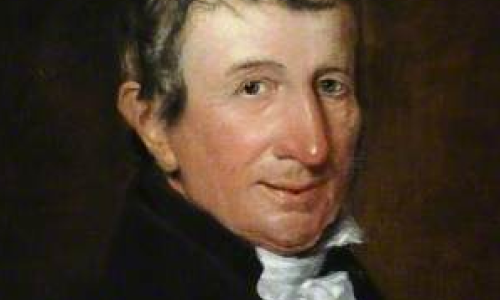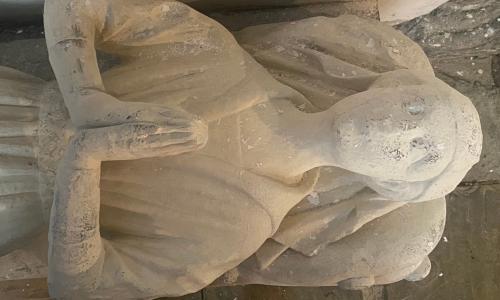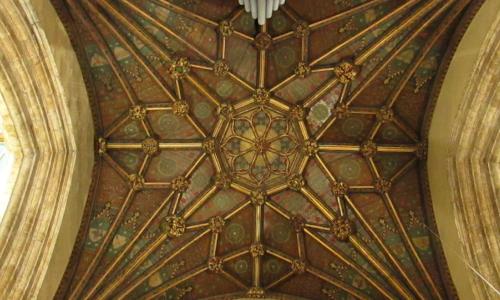Positioned as it is at the edge of two major rivers, firmly facing into the rush and bluster of the North Sea, Hull has held a firm importance in the minds of many influential figures, many of which wrote about their experiences. Indeed, from the 16th century onwards, the then town was increasingly described in detail and depth in single sources; previous indications of town life had been articulated solely, vaguely, and somewhat sporadically through the Meaux Chronicle, written by the town’s founders at Meaux Abbey 8 miles north of Hull, and through an abundance of cartularies and records written locally.
They offer a keen illustration of the life and times of Hull’s central church, the Church of the Holy Trinity, a masterpiece of Late Gothic and light and the city’s most enduring symbol. In this article, the first of several, we want to address the sources associated with Hull Minster in the 16th and 17th centuries. The following is a series of transcriptions of important documentary evidence for Holy Trinity church in Hull. Transcriptions at face value only provide superficial value; we want to look deeper. So, we will provide a short but complementary addendum to each source that will help discuss it in a bit more detail. Let’s begin with John Leland.
Reader's note: all sources are taken from D Woodward, Descriptions of East Yorkshire: Leland to Defoe (1985), except for De La Pryme, which comes from A De La Pryme, The History of Hull (Parts 1 and 2) (repub.1986).
John Leland, 1540
‘There be 2 chirchis yn the toun, the Trinite and St Maries, and nother of them by name of an hedde paroch chirche. The Trinite Chirch most made of brike is the larger a great deale and the fairer. Ther ly 4 notable chapples on the south syde of this chirch, cross islid. A chapel of the foundation of Hanby and one Richard Hansum marchuntes. The next is a chapel made as sum say by a chauncelar of Lincoln. The 3 is a chaple of stone, made by Bisshop Alcock, borne Beverle, wheryn Gul, Alcok and Johan, parents to the bishop to be buried, and ther is a cantuarie. The lowest chapelle is caullid the Mariners Chapelle. There is also a chapel in the body of the chirch made by one Rippellingham, prest, whos father a marchaunt of the toune lyith there: and ther is a cantuarie. Ther is a chapelle also on the north side of the cross isle of one Robert Frost, a marchaunt man. The tourre in the cross isle of this chirch for the belles is large and fair […] In the south side of this chirch yarde is the fre schole erected by Bishop Alcock. In the west end of the chirch yard is the fair row of lodgeings for prestes of the toun made by one John Grigge, Mayor of the toun, and by it is an hospitale made by the same John Grigge. And therby is the Mariners Hospital. Selbys hospital is on the north side of the church yard. Selby is buried yn the south side of the waulle of isle by the quire: and his wife also, with very fair images. The White Freres College stode by Beverlegate. The Percys were taken for founders of it. The Augustine freres stood at the east end of Trinitie Chirch.’
Commentary
As an influential early ‘proto-archaeologist’ and one of the most important local historians in the British history, Leland’s work is often crucial to researchers, and his commentary on Hull Minster is no different.
His description of the four southside chapels has proved especially useful, especially to the Back to life: Revival project at the Minster, but also for understanding the ecclesiastical foundations here in Hull. Hull was not a parish church until 1661, so the establishment of chapels and chantries and the existence of priests attached to them seems to have left the church in the bizarre situation of housing chantry and/or chapel priests but no resident vicar; this situation, it seems to me, is unparalleled in the whole of Yorkshire.
A major benefit of Leland’s work lies in his attention to detail. Here we get not just a view of the church, but of the associated ecclesiastical structures around about. Holy Trinity is not just an isolated chapel, but the central apex and focus of a major ecclesiastical complex- reminiscent of the abbey at Meaux that spawned it. Leland notes the existence of a free school, a churchyard, several private hospitals and a bedern for the priests alongside the church, all of which carried clear ecclesiastical associations during this period. In many respects Holy Trinity as Leland sees it epitomises the ideal Late Medieval church: central to civic and economic life, urban, open to private investment and capital, and more ‘secular’ than earlier monasteries and ecclesiastical foundations. Given the size of the church and the number of chantries and chapels it held, it is curious that it never became a collegiate establishment; here we may see the influence of Beverley Minster further up the Hull...
A final note; the sheer number of merchants mentioned in Leland show just how booming trade was in Hull. This was an outward-looking ambitious community, and its church reflects this.
Thomas Baskerville, 1677
‘It hath 2 churches, one a large, and well built church, to which the governor (Colonel Cilby) went on Sunday attended with a band of men who stay there in the churchyard and porch till prayers and sermons are ended, and then they wait upon him back again to his lodging.’
Commentary
Short and sweet, Baskerville’s mention doesn’t reveal very much. Who was this band of men? Bodyguards? Servants? It isn’t clear. As for Colonel Cilby, he was not the Governor of Hull in 1677; The Duke of Monmouth (the same of the late Monmouth Rebellion) was. Are we sure the gentleman mentioned here was Colonel Cilby and not Monmouth? Local antagonism towards Monmouth would make more sense, given the town’s staunch Roundhead views and his royal blood. Very mysterious.
Edmund Gibson, 1695
‘The town hath two churches, one called the High Church, a very spacious and beautiful building; on the south side of the Quire whereof is a place now alter’d into a neat library, consisting mostly of modern books.’
Commentary
Another short source, Gibson nevertheless gives us a clear indication of the location of Holy Trinity’s library. It was in existence by the 1660s at the latest, as Eleanor Crowle, a local wealthy merchant’s wife, was a large benefactor in 1665, and there are further mentions later in the century, including the addition of a library keeper in 1668. Today the location of the library is either the vestry or the Minster’s toilet facilities, or perhaps both. The books were transferred to the University of Hull in 1938.
Celia Fiennes, 1697
‘There is a good large Church in Hull, you enter a large isle just in the middle that runs quite across through the Church and divides the body of the Church, with the pulpet and pews on the side with a partition of wood carv’d, and on the other side was such another partition for the Chancell, and I observ’d there their alter stood table-wise for the communion just in the middle of the Chancell, as it was in the primitive tymes before Popery came in.’
Commentary
Fiennes’ entry reveals a little of the division of space within the church in the post-Reformation period. The church seems to have maintained two partitions into early modernity, one of which may have been the original roodscreen.
The survival of this in Hull seems odd given the town’s previous Roundhead sympathies, but these political inclinations were not always matched by religious fervour. Holy Trinity was a moderate church in several ways, and while it had followed Henry VIII in his break from Rome with relative enthusiasm, as with Henry himself it was no bastion of Protestantism early on.
The churchmanship veered from High Church to Puritanism during the 17th century, but it seems the regular quarrels between the puritanical clergy must’ve distracted them from effecting the destruction of the screen. This would also explain the survival of other woodwork in the chancel, principally the knight carvings next to the misericords.
Abraham De La Pryme, 'A History of Kingston upon Hull', c. 1700
‘1312: But the noblest work of those times was the building of the great and stately chapel of St. Trinitys in this town which is very magnificent and fine and was founded about this time by the noble beneficence of the king and merchants and tradesmen of this town and the ye liberall contributes of the whole country round about. And the first mention I meet with any where made thereof is in the will of John Scale one of the aforesaid jury who died in ye year aforesaid who bequeathed his body to to be buryed in St. Trinitys church yard and 20 shillings which was a great sun in those days to be paid out of his estate towards the raiseing of the said fabric and in the year 1327, another of the same sir name called William Scales of this town bequeathed his body to be buryed in the new chappell of St Trinitys. in this town.
1444: About a year or two after this died, John Greg, a rich merchant of this town and great benefactor to it … (he built)All the houses at the west end of Trinities Church, called ye priestes houses or the priests chambers for all the clergy belongong to Trinity Church to live freely in for ever and last of all after and … he founded two chanterys in ye aforesaid church for to pray for his soul and the soul of his wifes and all Christian souls ye one at the altar of St. Lawrence, and ye other at the altar of St, Mary, endowing them with ye yearly rent of 6 or 7 messuages in ye said town.’
Commentary
De La Pryme’s letters, histories and diaries are a fine resource. What does he say about Holy Trinity? He clearly approves of the architecture of the church, a far cry from Wren’s contemporaneous dismissive attitude towards the ‘saracenic’ Gothic. In typical fashion, his focus is on the merchanting and venturing that made Hull prosperous; a reflection of the mercantilism and emerging globalism of Pryme’s own era. He also notes, as with Leland, the surrounding buildings of the church. Interestingly his use of the present tense when talking about the priest chambers (or bedern) suggests that they are still extant in the late 17th century. Indeed, the Old Town of Hull would undergo its greatest revision and rebuilding over the 18th and 19th centuries- those changes were yet to come. By and large, the town that Pryme would have witnessed would have been late medieval and Tudor, just like its parish church.
Conclusion
So ends the 17th century sources. In our next article, we will focus on the more numerous articles covering the church in the 18th century, a period of relative quiet for the church after the chaos of the 1600s. Join us again soon to continue our journey through the sources of Hull Minster.
Bibliography
- Crowther, J: Descriptions of East Yorkshire: De La Pryme to Head, ed J Crowther, EYLHS, 1992.
- De La Pryme, A: The History of Hull (Parts 1 and 2); reprinted by Malet Lambert School, published by Hull CC, 1986.




